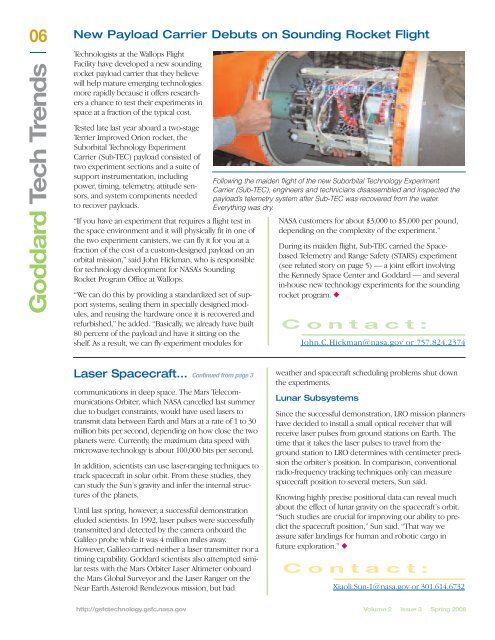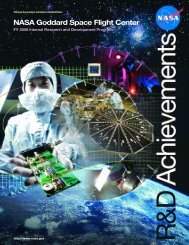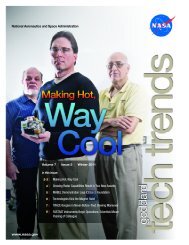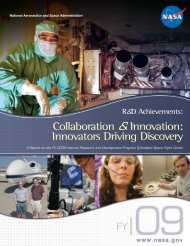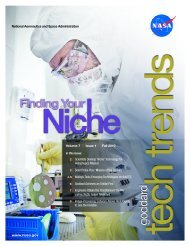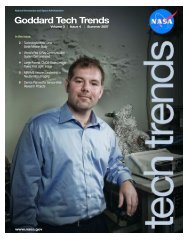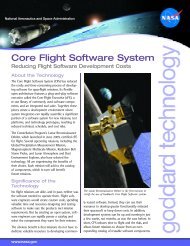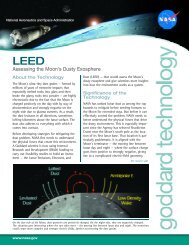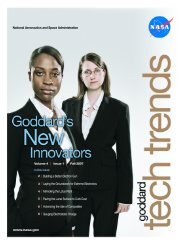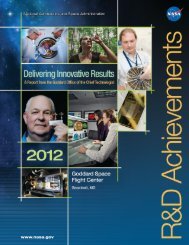Goddard Tech Trends - NASA's Goddard Technology Management ...
Goddard Tech Trends - NASA's Goddard Technology Management ...
Goddard Tech Trends - NASA's Goddard Technology Management ...
You also want an ePaper? Increase the reach of your titles
YUMPU automatically turns print PDFs into web optimized ePapers that Google loves.
06<br />
<strong>Goddard</strong> <strong>Tech</strong> <strong>Trends</strong><br />
New Payload Carrier Debuts on Sounding Rocket Flight<br />
<strong>Tech</strong>nologists at the Wallops Flight<br />
Facility have developed a new sounding<br />
rocket payload carrier that they believe<br />
will help mature emerging technologies<br />
more rapidly because it offers researchers<br />
a chance to test their experiments in<br />
space at a fraction of the typical cost.<br />
Tested late last year aboard a two-stage<br />
Terrier Improved Orion rocket, the<br />
Suborbital <strong>Tech</strong>nology Experiment<br />
Carrier (Sub-TEC) payload consisted of<br />
two experiment sections and a suite of<br />
support instrumentation, including<br />
power, timing, telemetry, attitude sensors,<br />
and system components needed<br />
to recover payloads.<br />
“If you have an experiment that requires a flight test in<br />
the space environment and it will physically fit in one of<br />
the two experiment canisters, we can fly it for you at a<br />
fraction of the cost of a custom-designed payload on an<br />
orbital mission,” said John Hickman, who is responsible<br />
for technology development for NASA’s Sounding<br />
Rocket Program Office at Wallops.<br />
“We can do this by providing a standardized set of support<br />
systems, sealing them in specially designed modules,<br />
and reusing the hardware once it is recovered and<br />
refurbished,” he added. “Basically, we already have built<br />
80 percent of the payload and have it sitting on the<br />
shelf. As a result, we can fly experiment modules for<br />
Following the maiden flight of the new Suborbital <strong>Tech</strong>nology Experiment<br />
Carrier (Sub-TEC), engineers and technicians disassembled and inspected the<br />
payload’s telemetry system after Sub-TEC was recovered from the water.<br />
Everything was dry.<br />
NASA customers for about $3,000 to $5,000 per pound,<br />
depending on the complexity of the experiment.”<br />
During its maiden flight, Sub-TEC carried the Spacebased<br />
Telemetry and Range Safety (STARS) experiment<br />
(see related story on page 5) — a joint effort involving<br />
the Kennedy Space Center and <strong>Goddard</strong> — and several<br />
in-house new technology experiments for the sounding<br />
rocket program. ◆<br />
Contact:<br />
John.C.Hickman@nasa.gov or 757.824.2374<br />
Laser Spacecraft... Continued from page 3<br />
communications in deep space. The Mars Telecommunications<br />
Orbiter, which NASA cancelled last summer<br />
due to budget constraints, would have used lasers to<br />
transmit data between Earth and Mars at a rate of 1 to 30<br />
million bits per second, depending on how close the two<br />
planets were. Currently, the maximum data speed with<br />
microwave technology is about 100,000 bits per second.<br />
In addition, scientists can use laser-ranging techniques to<br />
track spacecraft in solar orbit. From these studies, they<br />
can study the Sun’s gravity and infer the internal structures<br />
of the planets.<br />
Until last spring, however, a successful demonstration<br />
eluded scientists. In 1992, laser pulses were successfully<br />
transmitted and detected by the camera onboard the<br />
Galileo probe while it was 4 million miles away.<br />
However, Galileo carried neither a laser transmitter nor a<br />
timing capability. <strong>Goddard</strong> scientists also attempted similar<br />
tests with the Mars Orbiter Laser Altimeter onboard<br />
the Mars Global Surveyor and the Laser Ranger on the<br />
Near Earth Asteroid Rendezvous mission, but bad<br />
weather and spacecraft scheduling problems shut down<br />
the experiments.<br />
Lunar Subsystems<br />
Since the successful demonstration, LRO mission planners<br />
have decided to install a small optical receiver that will<br />
receive laser pulses from ground stations on Earth. The<br />
time that it takes the laser pulses to travel from the<br />
ground station to LRO determines with centimeter precision<br />
the orbiter’s position. In comparison, conventional<br />
radio-frequency tracking techniques only can measure<br />
spacecraft position to several meters, Sun said.<br />
Knowing highly precise positional data can reveal much<br />
about the effect of lunar gravity on the spacecraft’s orbit.<br />
“Such studies are crucial for improving our ability to predict<br />
the spacecraft position,” Sun said. “That way we<br />
assure safer landings for human and robotic cargo in<br />
future exploration.” ◆<br />
Contact:<br />
Xiaoli.Sun-1@nasa.gov or 301.614.6732<br />
http://gsfctechnology.gsfc.nasa.gov Volume 2 Issue 3 Spring 2006


